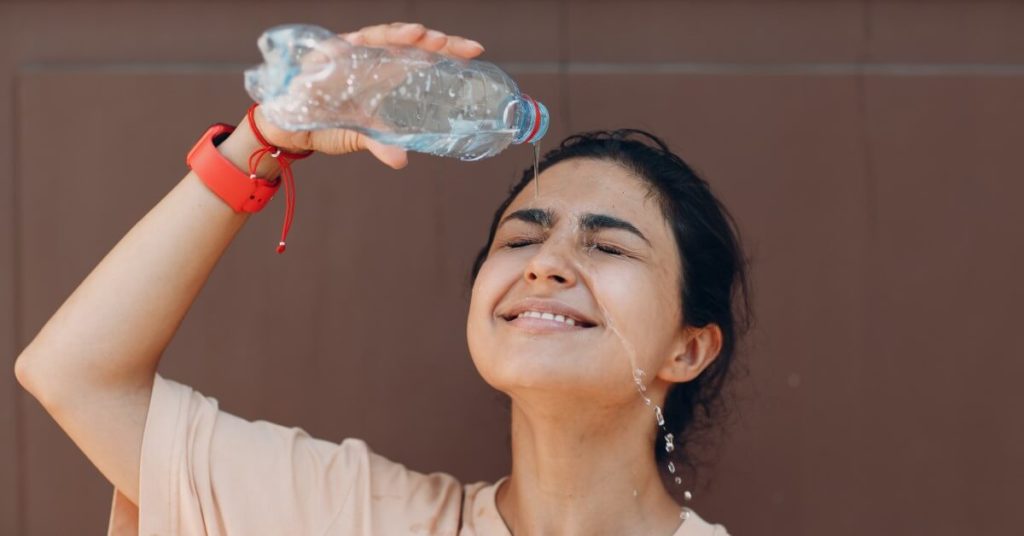
Understanding Heatstroke | Symptoms | Causes | Prevention and Treatment |
What’s the Takeaway?
Overview
As summer takes hold, the days grow longer and hotter. With temperatures soaring to record highs, the risk of heat-related illnesses, such as heat exhaustion and heatstroke, substantially increases.
Although heat exhaustion and heatstroke are both heat-related illnesses, they differ significantly in severity and symptoms.
Heat exhaustion manifests as heavy sweating, weakness, cold, pale, and clammy skin, fainting, and a weak pulse. Move to a cool place, drink water or sports drinks, take a cool shower or use cold compresses, and rest to prevent heat exhaustion from progressing to heatstroke.
Heatstroke is a severe condition marked by a body temperature over 104°F, hot, red skin, rapid and strong pulse, and possible unconsciousness, necessitating immediate medical attention.[1]
Keep reading to find out more about heatstroke and the steps you should take to prevent, diagnose and treat this potentially fatal condition.
Understanding Heatstroke
Heatstroke, also known as sunstroke, is the most severe form of heat injury, occurring when the body’s temperature rises above 104 degrees Fahrenheit (40 degrees Celsius).[2] It’s a medical emergency that, if untreated, can damage the brain, heart, kidneys, and muscles.[3]
Symptoms
Signs and symptoms of heatstroke can develop suddenly or gradually over time. The two types of heatstroke, classic and exertional, manifest differently:[4]
- Classic Heatstroke: Typically seen in older adults or people with chronic illnesses, symptoms develop over several days to weeks during a heatwave. They include confusion, altered mental state, agitation, and lack of sweating despite the heat.[5]
- Exertional Heatstroke: Symptoms commonly occur among young and healthy individuals after intense physical activity in the heat. These include a body temperature of 104 degrees Fahrenheit or higher, nausea, vomiting, rapid breathing, headache, and racing heart rate.[6]
Causes
Heatstroke occurs when the body’s thermoregulation system fails. Typically, the body cools itself by sweating. But in hot weather, particularly with high humidity, this cooling system can fail, increasing body temperature.[7]
The leading causes of heatstroke include prolonged or intense exercise during hot weather, wearing too much clothing, drinking alcohol, and dehydration.[8]
Prevention and Treatment
Prevention is the best defense against heatstroke. Stay hydrated, avoid strenuous activities during the hottest part of the day, wear loose, lightweight clothing, never leave anyone in a parked car, and take it easy during outdoor activities.[9]
Heatstroke is a medical emergency requiring immediate attention. If you or someone else has symptoms of heatstroke, call for emergency medical assistance. While waiting for help to arrive, try to cool the person down.
Move them to a cooler area, remove excess clothing, and apply cool water to their skin. If possible, use a fan to lower the person’s body temperature.[10]
What’s the Takeaway?
Heatstroke is a serious medical condition that can have grave consequences if left untreated.
As temperatures rise this summer, knowing the risks, symptoms, and preventive measures associated with heatstroke is essential.
Your health is invaluable; safeguard it by staying informed and taking appropriate precautions.
References:
- NHS. (2021). Heatstroke and Heat Exhaustion. Available at: https://www.nhs.uk/conditions/heat-exhaustion-heatstroke/
- Mayo Clinic. (2021). Heatstroke. Available at: https://www.mayoclinic.org/diseases-conditions/heat-stroke/symptoms-causes/syc-20353581
- Bouchama, A., Dehbi, M., & Chaves-Carballo, E. (2007). Cooling and hemodynamic management in heatstroke: practical recommendations. Critical care (London, England), 11(3), R54. https://doi.org/10.1186/cc5910
- Leon, L. R., & Bouchama, A. (2015). Heat stroke. Comprehensive physiology, 5(2), 611–647.
- World Health Organization. (2022). Heat-related illnesses. Available at: https://www.who.int/news-room/fact-sheets/detail/heat-related-illnesses
- Casa, D. J., DeMartini, J. K., Bergeron, M. F., Csillan, D., Eichner, E. R., Lopez, R. M., Ferrara, M. S., Miller, K. C., O’Connor, F., Sawka, M. N., & Yeargin, S. W. (2015). National Athletic Trainers’ Association Position Statement: Exertional Heat Illnesses. Journal of athletic training, 50(9), 986–1000. https://doi.org/10.4085/1062-6050-50.9.07
- Lim C. L. (2020). Fundamental Concepts of Human Thermoregulation and Adaptation to Heat: A Review in the Context of Global Warming. International journal of environmental research and public health, 17(21), 7795. https://doi.org/10.3390/ijerph17217795
- Mayo Clinic. (2021). Heatstroke. Available at: https://www.mayoclinic.org/diseases-conditions/heat-stroke/symptoms-causes/syc-20353581
- Centers for Disease Control and Prevention. (2022). Heat and Older Adults. Available at: https://www.cdc.gov/disasters/extremeheat/older-adults-heat.html
- National Institute for Occupational Safety and Health. (2022). Heat Stress – Heat Stroke. Available at: https://www.cdc.gov/niosh/topics/heatstress/heatstroke.html


